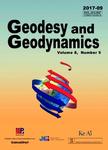A regional GNSS-VTEC model over Nigeria using neural networks: A novel approach
A regional GNSS-VTEC model over Nigeria using neural networks:A novel approach作者机构:NASRDA Center for Atmospheric Research Kogi State University Anyigba Campus Nigeria Ionospheric & Space Physics Laboratory Department of Physics University of Lagos Nigeria Department of Physics University of Calabar Nigeria Department of Physics Federal University of Agriculture Makurdi Nigeria Department of Surveying & Geo-informatics Nnamdi Azikiwe University Awka Nigeria
出 版 物:《Geodesy and Geodynamics》 (大地测量与地球动力学(英文版))
年 卷 期:2016年第7卷第1期
页 面:19-31页
学科分类:12[管理学] 081802[工学-地球探测与信息技术] 1201[管理学-管理科学与工程(可授管理学、工学学位)] 081104[工学-模式识别与智能系统] 08[工学] 081105[工学-导航、制导与控制] 0818[工学-地质资源与地质工程] 0804[工学-仪器科学与技术] 0835[工学-软件工程] 0811[工学-控制科学与工程] 0812[工学-计算机科学与技术(可授工学、理学学位)]
基 金:National Astrophysics and Space Science Program The World Academy of Sciences, TWAS The World Academy of Sciences, TWAS Chinese Academy of Sciences, CAS
主 题:Global Navigation Satellite System(GNSS) ionosphereTotal electron content (TEC)Nigerian permanent GNSS network(NIGNET)Neural networkInternational reference ionosphere(IRI)
摘 要:A neural network model of the Global Navigation Satellite System - vertical total electron content (GNSS-VTEC) over Nigeria is developed. A new approach that has been utilized in this work is the consideration of the International Reference Ionosphere's (IRI's) critical plasma frequency (foF2) parameter as an additional neuron for the network's input layer. The work also explores the effects of using various other input layer neurons like distur- bance storm time (DST) and sunspot number. All available GNSS data from the Nigerian Permanent GNSS Network (NIGNET) were used, and these cover the period from 2011 to 2015, for 14 stations. Asides increasing the learning accuracy of the networks, the inclusion of the IRI's foF2 parameter as an input neuron is ideal for making the networks to learn long-term solar cycle variations. This is important especially for regions, like in this work, where the GNSS data is available for less than the period of a solar cycle. The neural network model developed in this work has been tested for time-varying and spatial per- formances. The latest 10% of the GNSS observations from each of the stations were used to test the forecasting ability of the networks, while data from 2 of the stations were entirely used for spatial performance testing. The results show that root-mean-squared-errors were generally less than 8.5 TEC units for all modes of testing performed using the optimal network. When compared to other models, the model developed in this work was observed to reduce the prediction errors to about half those of the NeQuick and the IRI model.



